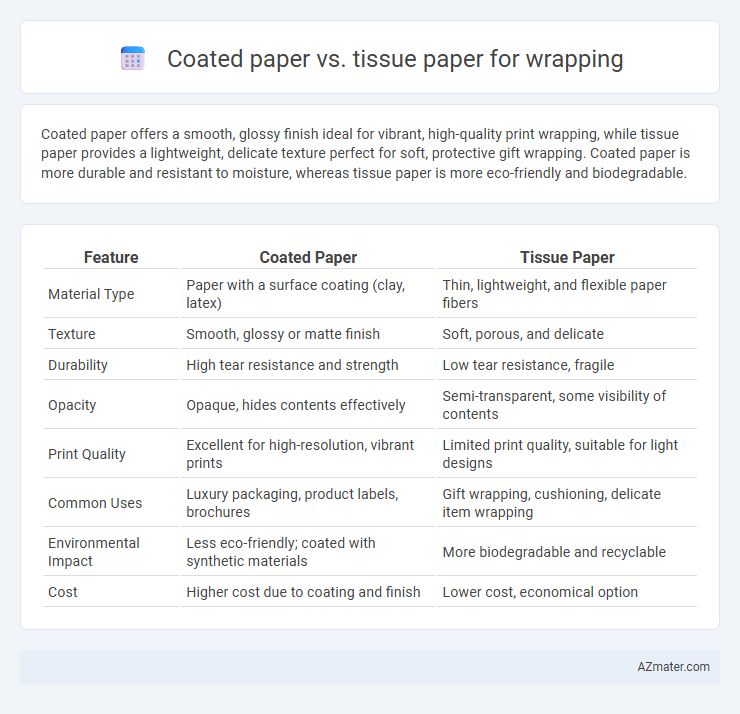Coated paper offers a smooth, glossy finish ideal for vibrant, high-quality print wrapping, while tissue paper provides a lightweight, delicate texture perfect for soft, protective gift wrapping. Coated paper is more durable and resistant to moisture, whereas tissue paper is more eco-friendly and biodegradable.
Table of Comparison
| Feature | Coated Paper | Tissue Paper |
|---|---|---|
| Material Type | Paper with a surface coating (clay, latex) | Thin, lightweight, and flexible paper fibers |
| Texture | Smooth, glossy or matte finish | Soft, porous, and delicate |
| Durability | High tear resistance and strength | Low tear resistance, fragile |
| Opacity | Opaque, hides contents effectively | Semi-transparent, some visibility of contents |
| Print Quality | Excellent for high-resolution, vibrant prints | Limited print quality, suitable for light designs |
| Common Uses | Luxury packaging, product labels, brochures | Gift wrapping, cushioning, delicate item wrapping |
| Environmental Impact | Less eco-friendly; coated with synthetic materials | More biodegradable and recyclable |
| Cost | Higher cost due to coating and finish | Lower cost, economical option |
Introduction to Wrapping Paper Types
Coated paper and tissue paper serve distinct purposes in wrapping, each offering unique benefits based on texture and durability. Coated paper features a smooth, glossy surface that enhances print quality and resists moisture, making it ideal for premium packaging and gift wrapping requiring sharp graphics. Tissue paper, known for its lightweight, soft, and translucent properties, is commonly used for delicate item protection and layering inside packages, adding a decorative and cushioning effect.
What is Coated Paper?
Coated paper features a surface sealed with a layer of clay or polymer, enhancing smoothness and print quality, making it ideal for high-end wrapping applications. It offers durability, resistance to moisture, and vibrant color reproduction, which sets it apart from tissue paper's delicate and porous nature. Coated paper is frequently used in packaging that requires a professional appearance and added protection, unlike tissue paper that is preferred for lightweight, decorative wrapping.
What is Tissue Paper?
Tissue paper is a lightweight, translucent paper made from thin fibers, designed primarily for delicate wrapping, cushioning, and decorative purposes. Unlike coated paper, tissue paper offers superior breathability and flexibility, making it ideal for protecting fragile items without adding bulk or rigidity. Its softness and ability to absorb moisture distinguish it as an essential material in packaging fragile goods, gift wrapping, and cosmetic applications.
Durability: Coated Paper vs Tissue Paper
Coated paper offers superior durability compared to tissue paper due to its protective layer that resists tearing, moisture, and abrasion, making it ideal for heavier or fragile items. Tissue paper is thinner and more delicate, often used for cushioning or decorative purposes but prone to ripping under stress. For wrapping applications requiring strength and longevity, coated paper provides better performance and protection.
Texture and Finish Comparison
Coated paper offers a smooth, glossy finish that enhances color vibrancy and provides a sleek, polished appearance ideal for high-end gift wrapping. Tissue paper features a soft, delicate texture with a matte finish, lending a subtle, elegant look suitable for layering and cushioning. The choice between coated and tissue paper depends on the desired tactile experience and visual impact in packaging design.
Print Quality and Visual Appeal
Coated paper offers superior print quality with sharp, vibrant images and a smooth, glossy finish that enhances color depth, making it ideal for high-end product wrapping where visual appeal is paramount. Tissue paper provides a soft, translucent texture with muted print clarity, lending an elegant, delicate look typically favored for gift wrapping and luxury packaging requiring a subtle aesthetic. The choice between coated paper and tissue paper depends on the desired combination of print precision and tactile sophistication in wrapping applications.
Environmental Impact and Sustainability
Coated paper typically involves plastic or clay-based layers that hinder biodegradability and recycling, resulting in increased environmental burden compared to tissue paper. Tissue paper, made from unbleached or recycled fibers, decomposes faster and supports sustainable waste management with lower carbon footprints. Choosing tissue paper for wrapping reduces landfill waste and enhances overall eco-friendly packaging practices.
Cost Effectiveness Analysis
Coated paper offers superior print quality and durability at a higher cost, making it suitable for premium packaging but less budget-friendly for large-scale use. Tissue paper is more cost-effective for bulk wrapping due to its lower price and lightweight nature, though it lacks the strength and moisture resistance of coated paper. Evaluating the overall cost-effectiveness requires balancing the need for visual appeal against budget constraints and the intended use of the wrapping material.
Ideal Uses for Coated Paper and Tissue Paper
Coated paper offers a smooth, glossy finish ideal for high-end gift wrapping, product packaging, and promotional materials where vibrant colors and sharp graphics are essential. Tissue paper excels in delicate wrapping tasks, such as cushioning fragile items, lining gift boxes, and adding a decorative layer due to its lightweight, translucent, and soft texture. Each type caters to different needs: coated paper ensures durability and visual appeal, while tissue paper provides protection and elegance for sensitive or breakable goods.
Which is Better: Final Considerations
Coated paper offers superior durability and moisture resistance, making it ideal for gift wrapping that requires a polished, high-quality finish and enhanced protection. Tissue paper excels in flexibility and softness, suitable for delicate items and layering but lacks the sturdiness of coated paper. Choosing between coated paper and tissue paper depends on the priority of either aesthetic elegance and durability or lightweight cushioning and gentleness.

Infographic: Coated paper vs Tissue paper for Wrapping
 azmater.com
azmater.com